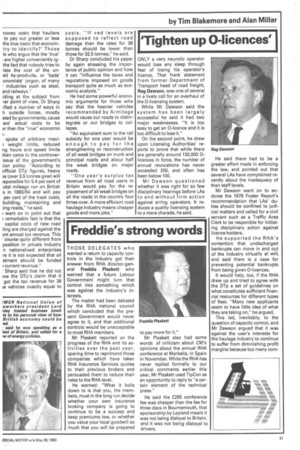I 'Tighten up 0-licences' I
Page 33

Page 34

If you've noticed an error in this article please click here to report it so we can fix it.
ONLY a very neurotic operator would lose any sleep through fear of losing his operator's licence. That frank statement from former Department of Transport head of road freight, Reg Dawson, was one of several in a lively call for an overhaul of the 0-licensing system.
While Mr Dawson said the system has been largely successful he said it had two major weaknesses. "It is too easy to get an 0-licence and it is too difficult to lose it."
On the second point, he drew upon Licensing Authorities' reports to prove that while there are generally around 130,000 0licences in force, the number of annual revocations has never exceeded 200, and often has been below 100.
Mr Dawson questioned whether it was right for so few disciplinary hearings before LAs to end without firm action against erring operators. It reduces a quality licensing system to a mere charade, he said. He said there had to be a greater effort made in enforcing the law, and pointed out that several LAs have complained recently about the inadequacy of their staff levels.
Mr Dawson went on to endorse the 1978 Foster Report's recommendation that LAs' duties should be confined to judicial matters and called for a civil servant such as a Traffic Area Clerk to be responible for initiating disciplinary action against licence holders.
He supported the RHA's contention that undischarged bankrupts can move in and out of the industry virtually at will, and said there is a case for preventing potential bankrupts from being given 0-licences.
It would help, too, if the RHA drew up and tried to agree with the DTp a set of guidelines on what constitutes sufficient financial resources for different types of fleet. "Many new applicants seem to have little idea of what they are taking on," he argued.
This led, inevitably, to the question of capacity control, and Mr Dawson argued that it was against the user's interests for the haulage industry to continue to suffer from diminishing profit margins because too many corn panies are in the market.
To counter this, he said there should be an additional clause in the 1968 Transport Act requiring the LA to refuse a standard 0licence if it would increase capacity far beyond the demands of the user.
It would not be easy to win the battle for such a change, and the Freight Transport Association would put up a strong fight against it. For any Government to accept that change, it would have to be proved that it was not just a protectionist measure, but would bring wider benefits to the public.
Mr Dawson's comments proved to be a trigger for a call for a return to quantity licensing, with Cliff Wilson (Williams Transport) saying that existing 0-licence holders should have a statutory right of objection to any new application or for variations to existing licences.
Tipper group chairman Brian Thackray agreed. There was a "massive over-capacity" in the industry, thanks to the change from carriers' licensing to 0licensing, and the floodgates had been opened to "anybody and everybody" to run vehicles for hire or reward. Own-account companies carrying hire or reward traffic were depressing ratesto "half of what they should be". Tom Llewellyn (Econofreight) wanted senders to be made responsible for providing operators with legal loads, and suggested this would eliminate the need for roadside checks. "Overloading would become a non-event," he predicted.
But Mr Dawson was less sure. There was a possibility that senders would be charged with aiding and abetting an operator to overload a vehicle, but as the sender seldom had an 0-licence to lose, it would be difficult to enforce anything else. It would also be unfair to put the onus entirely on the sender as he would not necessarily be aware of the problems of individual axle loads and weight distribution.
The LAs' case was defended by Yorkshire and Northern LA John Carpenter who said that companies usually tightened up their maintenance procedures when a licence was curtailed to run for less than its full term.




















































































































